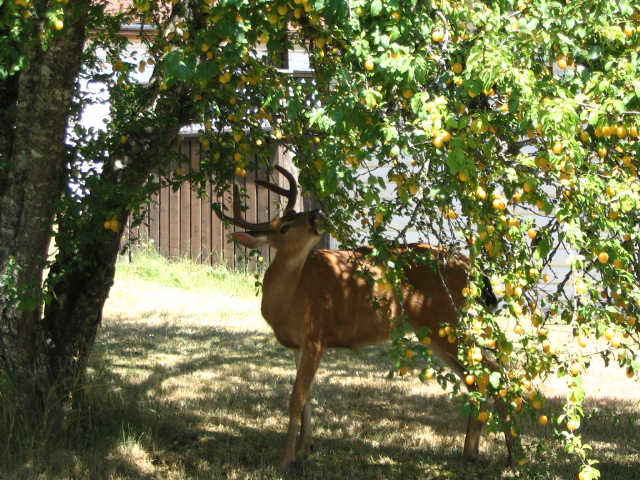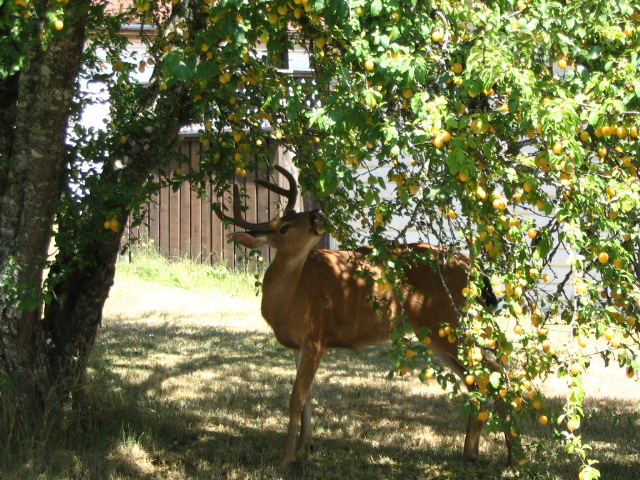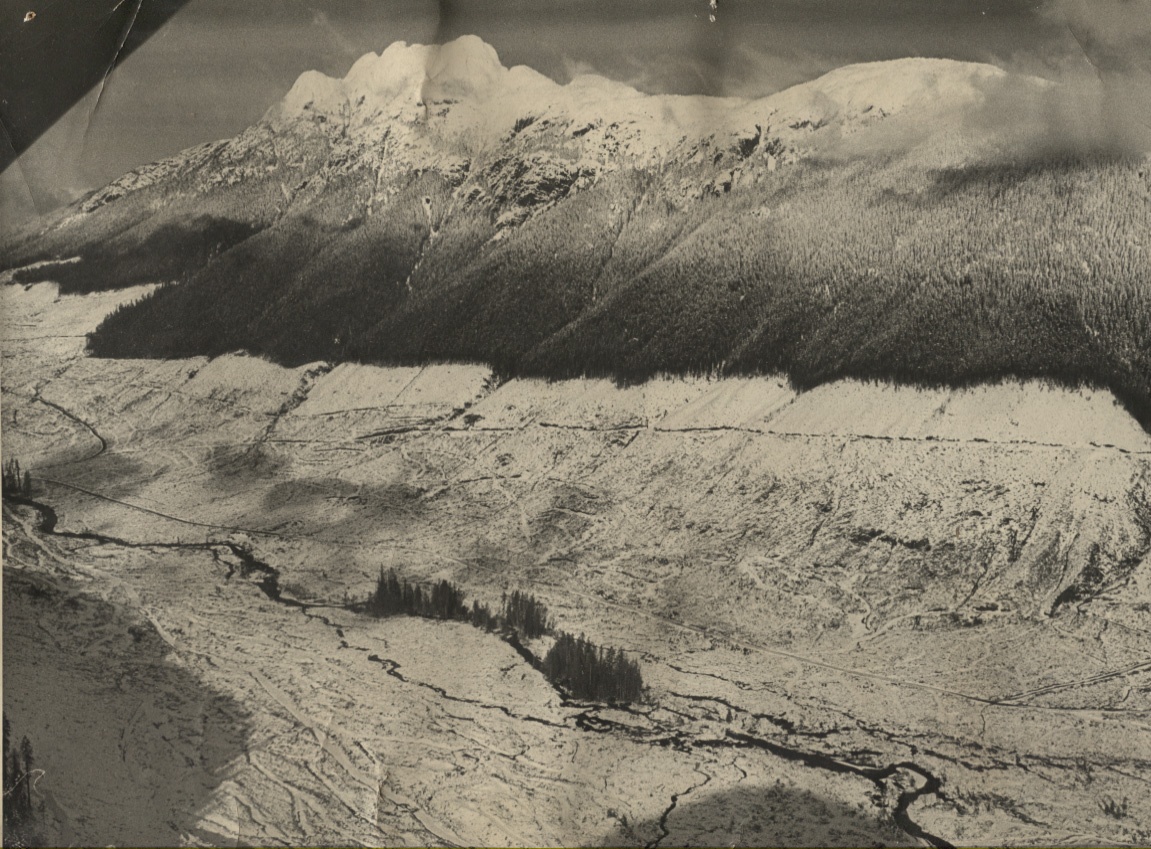THE LAKE NEWS, Lake Cowichan, B.C. Wednesday November 30, 1988
Deer on decline? Or Not?
By Ted Burns
I’ve forgotten the year but it wasn’t more than 10 or 12 years ago. I was searching for a waterfall on the east fork of the Robertson River when I came across a large rut in the ground, almost a trench. I scratched my head for a while before realizing what I’d found: an old deer runway (trail) from the days when the Cowichan Lake area had one of the largest deer populations on Vancouver Island. Those times are long gone. Deer have declined remarkably here and all over the island in the last few decades. The main reason …the tight canopy of second growth forests.
Early logging and accompanying fires created a bonanza for deer. Thousands of hectares of new slash and nutritious browse. And there was still lots of old growth to provide food and shelter in harsh winters. Deer became as numerous as grasshoppers in the dry fields of August. In the Nimpkish Valley, the last area in the Douglas fir zone to experience ideal habitat conditions, I counted more than 800 deer along a two-mile stretch of road. The year was 1972.
But the rapid progressive clear cutting that caused deer populations to climb is also the main reason for their fall. As the new forest returned, its canopy cut off sunlight and the deer food supply. Because logging was so rapid, large areas of relatively even-aged second growth now cover much of the east slope of Vancouver Island and deer are the worse for it. Deer were never abundant on the West Coast of the Island except in scattered pockets.
There are now more deer in old growth forests than in second growth. The stands are not as dense, there are more natural openings and the lichens that grow on old trees provide a good deal of food when branches are brought down by winds or decay. Tree lichens are the major food source of deer in winter.
Should a severe winter occur in the near future, there could be a catastrophic deer die-off because the winter habitat value of second growth is low. The last really hard winter on the South Coast was 1968-69. 20 years ago.
It’s not likely that there will ever be very large numbers of deer on Vancouver Island again in my life time. The old growth forests are still being opened on the West Slope but soil nutrients are low in cedar-hemlock forests and there are few deer even in ideal habitat. Deer will always be present however and there will be pockets of abundance as there are now, particularly in mountain herds and in the lowland resident deer around farm land.
There could be reasonable numbers of deer again if the rate of future logging is not so rapid and it is spaced over larger areas; a more patchwork pattern instead of progressive clear cutting. And if selected stands of timber are left to reach old age and provide winter range, deer numbers could someday approach those of years ago. There may still be a few stands of what I call core habitat – scruffy old growth on rocky south and west facing slopes with lots of lichens. These places must be absolutely protected. I don’t think it will happen but the choice is there.
Update – July 20, 2020
It is now 2020 and deer have become urbanized. There are more than a few places in BC where deer are now almost pests. I moved to Port Alberni in 2018 and, on the first trip downtown, we saw a four point buck marching down Third Avenue which is the main street. It was a quiet Sunday morn and Port Alberni is by no means an expanding metropolis. It has lost population since the 1970’s. But I was still surprised. I shouldn’t have been. The lady we bought our house from kept a paint ball gun handy to protect her flowers. We took no action and now have several deer that are part of the family. We are kind of on the edge of town and deer love the place. Important stuff is fenced but the deer are constantly on the lookout for something that over tops or pokes thru the
fences,
Other island communities are similar. Even parts of Victoria have deer. Some of these places are quite urban – to developed for deer but they are there, Never mind Grand Forks or Cranbrook which have lots of deer.
As surprising at it may be to see a deer family in your yard, you still do not see many out in the bush. Some people think that deer have adapted to the urban life for protection from predators. I think they are simply taking advantage of the superior habitat conditions provide by the favorable mix of openings, forest patches at variable seral stages along with gardens and fruit trees.
I should say that overall logging practices have improved greatly since the early seventies. Smaller, openings, less roads and improved streamside and riparian treatment but the rush to replenish harvestable stands is not going to change and most of the working forest will be tree farms of questionable habitat value for deer.

A nice buck feasting on plums near my Lake Cowichan driveway
THE LAKE NEWS, Lake Cowichan, B.C. Wednesday November 30, 1988
Deer on decline? Or Not?
By Ted Burns
I’ve forgotten the year but it wasn’t more than 10 or 12 years ago. I was searching for a waterfall on the east fork of the Robertson River when I came across a large rut in the ground, almost a trench. I scratched my head for a while before realizing what I’d found: an old deer runway (trail) from the days when the Cowichan Lake area had one of the largest deer populations on Vancouver Island. Those times are long gone. Deer have declined remarkably here and all over the island in the last few decades. The main reason …the tight canopy of second growth forests.
Early logging and accompanying fires created a bonanza for deer. Thousands of hectares of new slash and nutritious browse. And there was still lots of old growth to provide food and shelter in harsh winters. Deer became as numerous as grasshoppers in the dry fields of August. In the Nimpkish Valley, the last area in the Douglas fir zone to experience ideal habitat conditions, I counted more than 800 deer along a two-mile stretch of road. The year was 1972.
But the rapid progressive clear cutting that caused deer populations to climb is also the main reason for their fall. As the new forest returned, its canopy cut off sunlight and the deer food supply. Because logging was so rapid, large areas of relatively even-aged second growth now cover much of the east slope of Vancouver Island and deer are the worse for it. Deer were never abundant on the West Coast of the Island except in scattered pockets.
There are now more deer in old growth forests than in second growth. The stands are not as dense, there are more natural openings and the lichens that grow on old trees provide a good deal of food when branches are brought down by winds or decay. Tree lichens are the major food source of deer in winter.
Should a severe winter occur in the near future, there could be a catastrophic deer die-off because the winter habitat value of second growth is low. The last really hard winter on the South Coast was 1968-69. 20 years ago.
It’s not likely that there will ever be very large numbers of deer on Vancouver Island again in my life time. The old growth forests are still being opened on the West Slope but soil nutrients are low in cedar-hemlock forests and there are few deer even in ideal habitat. Deer will always be present however and there will be pockets of abundance as there are now, particularly in mountain herds and in the lowland resident deer around farm land.
There could be reasonable numbers of deer again if the rate of future logging is not so rapid and it is spaced over larger areas; a more patchwork pattern instead of progressive clear cutting. And if selected stands of timber are left to reach old age and provide winter range, deer numbers could someday approach those of years ago. There may still be a few stands of what I call core habitat – scruffy old growth on rocky south and west facing slopes with lots of lichens. These places must be absolutely protected. I don’t think it will happen but the choice is there.
Update – July 20, 2020
It is now 2020 and deer have become urbanized. There are more than a few places in BC where deer are now almost pests. I moved to Port Alberni in 2018 and, on the first trip downtown, we saw a four point buck marching down Third Avenue which is the main street. It was a quiet Sunday morn and Port Alberni is by no means an expanding metropolis. It has lost population since the 1970’s. But I was still surprised. I shouldn’t have been. The lady we bought our house from kept a paint ball gun handy to protect her flowers. We took no action and now have several deer that are part of the family. We are kind of on the edge of town and deer love the place. Important stuff is fenced but the deer are constantly on the lookout for something that over tops or pokes thru the
fences,
Other island communities are similar. Even parts of Victoria have deer. Some of these places are quite urban – to developed for deer but they are there, Never mind Grand Forks or Cranbrook which have lots of deer.
As surprising at it may be to see a deer family in your yard, you still do not see many out in the bush. Some people think that deer have adapted to the urban life for protection from predators. I think they are simply taking advantage of the superior habitat conditions provide by the favorable mix of openings, forest patches at variable seral stages along with gardens and fruit trees.
I should say that overall logging practices have improved greatly since the early seventies. Smaller, openings, less roads and improved streamside and riparian treatment but the rush to replenish harvestable stands is not going to change and most of the working forest will be tree farms of questionable habitat value for deer.

A nice buck feasting on plums near my Lake Cowichan driveway
